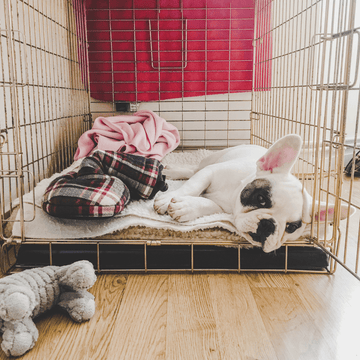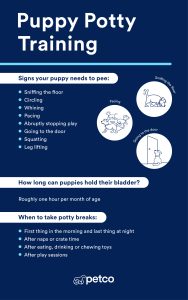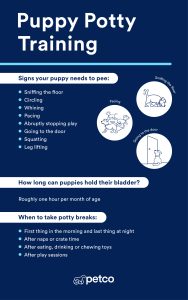Are you struggling to keep your puppy safe and happy while you’re busy or away? Crate training could be the simple solution you need.
When done right, it helps your puppy feel secure, reduces accidents, and makes house training easier. But how do you get started without stress—for both you and your furry friend? Keep reading to discover the best crate training tips that will make this process smooth, effective, and even enjoyable for your puppy.
Your journey to a well-behaved, confident dog begins here.
Benefits Of Crate Training
Crate training helps puppies learn good habits. It gives them a special space to feel calm and safe.
This training makes life easier for owners and dogs. It supports housebreaking and travel needs.
Safety And Security
A crate offers puppies a safe place to rest. It keeps them away from household dangers.
Dogs feel secure inside their crate. It helps reduce stress and anxiety in new environments.
Housebreaking Aid
Crates help puppies learn to hold their bladder. Dogs avoid soiling their sleeping area.
Using a crate teaches puppies to wait for bathroom breaks. This makes house training faster.
- Limits accidents inside the home
- Encourages bathroom routines
- Teaches self-control
Travel Convenience
Crates make traveling with puppies safer. They prevent dogs from moving around too much.
Using a crate helps puppies feel calm in cars or planes. It provides a familiar space during trips.

Credit: www.skipperspetproducts.com
Choosing The Right Crate
Picking the best crate for your puppy helps with training and safety. The right crate offers comfort and security for your new friend.
There are many crates available. You should know the types, size, and materials to find the right one.
Types Of Crates
You can choose from different crate styles. Each type has benefits for puppies and owners.
- Wire Crates:Good ventilation and visibility. Easy to clean and fold.
- Plastic Crates:Cozy and private. Great for travel and car rides.
- Soft-Sided Crates:Lightweight and portable. Best for calm puppies and short use.
- Heavy-Duty Crates:Strong and secure. Suitable for chewers and escape artists.
Size Matters
The crate should fit your puppy well. It needs enough room to stand, turn, and lie down comfortably.
| Size Category | Length (inches) | Width (inches) | Height (inches) | Best For |
|---|---|---|---|---|
| Small | 18 – 22 | 12 – 16 | 14 – 17 | Tiny breeds and young puppies |
| Medium | 24 – 30 | 18 – 21 | 19 – 22 | Small to medium breeds |
| Large | 36 – 42 | 23 – 28 | 25 – 30 | Large breeds and growing puppies |
| Extra Large | 48 – 54 | 30 – 34 | 32 – 36 | Very large breeds |
Material Options
Crates come in many materials. The choice affects durability, comfort, and cleaning.
- Metal:Durable and secure but can be heavy and noisy.
- Plastic:Cozy and quiet but less breathable.
- Fabric:Lightweight and portable but less sturdy.
Preparing The Crate
Crate training helps your puppy feel secure and safe. Preparing the crate properly is key to success.
Follow these tips to ensure your puppy is comfortable and happy in their crate.
Comfortable Bedding
The right bedding makes the crate cozy and inviting. Choose materials that are soft and easy to clean.
- Use a soft blanket or mat for comfort
- Choose machine-washable materials
- Avoid bedding that is easily chewed or shredded
Safe Location
Place the crate in a location that is safe and free from distractions. This helps your puppy feel at ease.
Avoid putting the crate in direct sunlight or near loud noises. A quiet corner in a family room often works well.
Introducing Toys
Toys can make the crate a fun and welcoming place. Choose toys that are safe and suitable for your puppy’s size.
Consider these toy options:
- Chew toys to keep your puppy entertained
- Interactive toys that challenge your puppy’s mind
- Stuffed toys for comfort
Starting Crate Training
Crate training helps puppies learn to stay calm and safe. It creates a special space just for them.
Start slow and use kindness. This makes the crate a happy place for your puppy.
Positive Associations
Make the crate a place your puppy likes. Use soft bedding and toys inside. Let the door stay open at first.
- Place treats inside the crate
- Give your puppy time to explore on their own
- Speak gently and calmly near the crate
- Feed meals inside the crate to build good feelings
Short Initial Sessions
Keep the first crate times short. This helps your puppy feel safe and not trapped.
| Session Length | Activity |
| 5 minutes | Let puppy explore with door open |
| 10 minutes | Close door while puppy eats |
| 15 minutes | Stay nearby and talk softly |
| 20 minutes | Leave room for short time |
Using Treats And Praise
Use treats and praise to reward your puppy. This shows the crate is a good place.
- Give a treat when puppy enters the crate
- Use a happy voice to say “good” or “yes”
- Offer treats during calm moments inside the crate
- End sessions with praise and gentle petting
Building Crate Time
Crate training helps puppies feel safe and secure. Building crate time takes patience and care.
Start slow and make the crate a happy place. This guide shows how to build crate time step by step.
Gradual Increases
Begin with short crate sessions. Let your puppy explore the crate with the door open. Add treats inside to create interest.
- Place your puppy in the crate for 5 minutes.
- Stay nearby and speak softly.
- Slowly increase time by 5 minutes daily.
- Keep sessions calm and positive.
- End with praise and a treat.
Maintaining Calmness
Calmness helps puppies feel safe in their crate. Avoid rushing or forcing them inside. Use soft tones and gentle petting to soothe your puppy.
| Calmness Tip | Why It Helps |
| Speak softly | Reduces stress and fear |
| Gentle petting | Builds trust and comfort |
| Stay nearby | Makes puppy feel safe |
| Use familiar toys | Creates a cozy environment |
Handling Resistance
Some puppies resist crate time. Be patient and avoid punishment. Try these methods to ease resistance.
- Ignore whining if it is for attention.
- Give treats only when calm inside the crate.
- Use a command like “crate” to build routine.
- Increase crate time in small, easy steps.
- Make sure the crate is comfortable and clean.

Credit: www.airtasker.com
Dealing With Common Challenges
Crate training your puppy can be tricky. Some problems often come up during training. Knowing how to handle these issues helps your puppy feel safe and calm.
This guide covers common challenges like whining, separation anxiety, and accidents in the crate. Use these tips to make training easier.
Whining And Barking
Puppies often whine or bark in the crate to get attention or because they feel uncomfortable. It is important not to reward this behavior by letting them out when they make noise.
- Ignore whining for a few minutes to see if your puppy settles down.
- Make the crate cozy with a soft blanket and favorite toys.
- Give your puppy enough exercise before crate time to reduce energy.
- Use calm praise when your puppy is quiet in the crate.
Separation Anxiety
Some puppies feel very stressed when left alone in their crate. Signs include heavy panting, drooling, or trying to escape.
| Cause | How to Help |
| New environment | Keep the crate in a familiar room with your scent nearby. |
| Sudden alone time | Practice short separations and increase time gradually. |
| Lack of stimulation | Provide chew toys and puzzle feeders in the crate. |
| Fear of being trapped | Leave the door open sometimes so puppy can explore. |
Accidents In The Crate
Puppies may have accidents in the crate if they are too young or left too long. Clean accidents quickly and avoid punishment.
- Take your puppy outside to potty often, especially before crate time.
- Use a crate size that is just big enough to stand, turn, and lie down.
- Establish a regular feeding and potty schedule.
- Clean accidents with an enzyme cleaner to remove odors.
Crate Training Tips For Nighttime
Crate training your puppy at night helps them feel safe and secure. It also teaches them good sleeping habits. Here are some tips to make nighttime crate training smoother.
Establishing A Routine
A routine helps your puppy know what to expect. It can reduce anxiety. Set a bedtime for your puppy and stick to it every night.
- Feed your puppy a few hours before bedtime.
- Take them outside for a potty break before crating.
- Playtime should end 30 minutes before bed.
Location For Sleep
The crate should be in a quiet and cozy place. Puppies sleep better in familiar surroundings. Make sure the area is not too hot or cold.
Placing a blanket or a soft bed inside the crate makes it more comfortable. Keep the crate away from loud noises.
Nighttime Potty Breaks
Puppies have small bladders. They may need a potty break at night. Be prepared to take them out if they start whining.
- Set an alarm to wake up for a scheduled potty break.
- Keep the outing calm and quiet to encourage quick returns to sleep.
- Use a leash to guide your puppy to the potty spot.
When To Avoid Crate Training
Crate training can help many puppies learn good habits. But it is not always the best choice. Some situations make crate training harmful or stressful.
Knowing when to avoid crate training helps keep your puppy happy and healthy. Here are key times to skip or delay it.
Health Concerns
Puppies with health problems should not be crate trained until fully recovered. Crates can limit movement and cause discomfort.
Illness, injury, or pain can make a crate feel like a trap. This can increase stress and slow healing.
- Dogs with breathing problems may struggle in small crates.
- Puppies with arthritis need space to stretch.
- Recovering dogs may need special care outside the crate.
Behavioral Issues
Puppies with fear or anxiety might get worse in a crate. If they panic, they can hurt themselves trying to escape.
Some dogs see the crate as punishment. This creates bad feelings and makes training harder.
- Severe separation anxiety may need other treatments.
- Fearful puppies need slow, gentle crate introduction.
- Avoid crates if your puppy shows strong stress signs.
Alternative Methods
When crate training is not right, try other ways to keep puppies safe and calm. These methods can work well too.
Use playpens, baby gates, or supervised free roam to create a safe space without a crate.
- Playpens give space but keep puppies contained.
- Baby gates block off parts of the home.
- Supervised time helps puppies learn good behavior.
Maintaining Crate Training Success
Crate training helps puppies feel safe and learn good habits. Keeping the training consistent is important for long-term success.
To maintain crate training success, you need to follow simple routines and encourage your puppy in a positive way.
Consistent Schedule
Keep your puppy on a regular schedule for crate time. This helps them know what to expect every day.
Use the same times for feeding, play, and crate rest. This builds a strong routine that your puppy understands.
- Set regular crate times each day
- Feed meals at the same time
- Plan crate breaks after play or bathroom trips
Regular Exercise
Exercise helps your puppy use up energy before crate time. A tired puppy rests better in the crate.
Play games, take walks, or run outside before putting your puppy in the crate. This reduces restlessness.
- Give your puppy 20-30 minutes of exercise daily
- Use playtime to burn off extra energy
- Exercise helps reduce barking or whining in the crate
Positive Reinforcement
Reward your puppy for calm behavior in the crate. This makes them want to stay inside happily.
Use treats, praise, or toys to show your puppy that crate time is good. Avoid punishment near the crate.
- Give treats when your puppy enters the crate
- Use a calm voice to praise them
- Ignore whining or barking instead of punishing

Credit: www.diamondpet.com
Frequently Asked Questions
How Long Should Puppy Crate Training Sessions Last?
Start with short sessions of 10-15 minutes to build comfort. Gradually increase time as the puppy adapts. Avoid leaving the puppy in the crate too long to prevent stress or accidents.
What Is The Best Age To Start Crate Training Puppies?
Begin crate training as early as 8 weeks old. Puppies learn quickly at this age and adapt well to routines. Early training helps establish good habits and reduces anxiety.
How Can I Make The Crate Comfortable For My Puppy?
Add soft bedding and familiar toys inside the crate. Ensure good ventilation and a quiet location. A cozy crate encourages your puppy to see it as a safe space.
Should I Use Treats During Crate Training?
Yes, use treats to reward your puppy when entering or staying calm in the crate. Positive reinforcement speeds up training and creates a pleasant association with the crate.
Conclusion
Crate training helps puppies feel safe and comfortable. Start slow and use treats to encourage good behavior. Keep sessions short and fun to avoid stress. Be patient; every puppy learns at their own pace. Consistency and kindness build trust and success.
A happy puppy means a happy home. Keep practicing daily for best results. Your puppy will soon love their crate.

Emily Barker is the founder of ChillDogLife.com, a space dedicated to helping pup parents discover the best dog products, lifestyle tips, and cozy ideas for happier homes.
A lifelong dog lover, Emily combines her passion for pets with a knack for research to share trusted recommendations on everything from toys and furniture to health and everyday care.
Her goal is simple: to make life easier, stylish, and more joyful for dogs and the people who love them.







